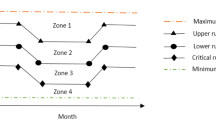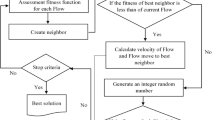Abstract
Operating rule curves have been widely applied to reservoir operation, due to their ease of implementation. However, these curves are generally used for single reservoirs and have rarely been applied to cascade reservoirs. This study was conducted to derive joint operating rule curves for cascade hydropower reservoirs. Steps in the proposed methodology include: (1) determining the optimal release schedule using dynamic programming to solve a deterministic long-term operation model, (2) identifying the forms of operating rule curves suitable for cascade hydropower reservoirs based on the optimal release schedule, (3) constructing a simulation-based optimization model and then using the non-dominated sorting genetic algorithm-II (NSGA-II) to identify the key points of the operating rule curves, (4) testing and verifying the efficiency of the generated joint operating rule curves using synthetic inflow series. China’s Qing River cascade hydropower reservoirs (the Shuibuya, Geheyan and Gaobazhou reservoirs) were selected for a case study. When compared with the conventional operating rule curves, the annual power generation can be increased by 2.62% (from 7.27 to 7.46 billion kWh) using the observed inflow from 1951 to 2005, as well as by about 1.77% and 2.52% using the synthetic inflows generated from two alternative hydrologic simulation methods. Linear operating rules were also implemented to simulate coordinated operation of the Qing River cascade hydropower reservoirs. The joint operating rule curves were more efficient and reliable than conventional operating rule curves and linear operating rules, indicating that the proposed method can greatly improve hydropower generation and work stability.
Similar content being viewed by others
References
Archibald TW, McKinnon KIM, Thomas LC (1997) An aggregate stochastic dynamic programming model of multi-reservoir systems. Water Resour Res 33(2):333–340
Bhaskar NR, Whitlatch EE (1980) Derivation of monthly reservoir release policies. Water Resour Res 16(6):987–993
Celeste AB, Billib M (2009) Evaluation of stochastic reservoir operation optimization models. Adv Water Resour 32(9):1429–1443
Chandramouli V, Raman H (2001) Multi-reservoir modeling with dynamic programming and neural networks. J Water Resour Plan Manage ASCE 127(2):89–98
Chang L-C (2008) Guiding rational reservoir flood operation using penalty-type genetic algorithm. J Hydrol 354:65–74
Chang F-J, Chen L, Chang L-C (2005) Optimizing the reservoir operation rule curves by genetic algorithms. Hydrol Process 19(11):2277–2289
Chaves P, Kojiri T (2007) Deriving reservoir operational strategies considering water quantity and quality objectives by stochastic fuzzy neural networks. Adv Water Resour 30(5):1329–1341
Chen L, McPhee J, Yeh WW-G (2007) A diversified multi-objective GA for optimizing reservoir rule curves. Adv Water Resour 30(5):1082–1093
Chiu Y-C, Chang L-C, Chang F-J (2007) Using a hybrid genetic algorithm-simulated annealing algorithm for fuzzy programming of reservoir operation. Hydrol Process 21(23):3162–3172
Deb K, Pratap A, Agarwal S, Meyarivan T (2002) A fast and elitist multiobjective genetic algorithm: NSGA-II. IEEE Trans Evol Comput 6(2):182–197
Guo S, Zhang H, Chen H, Peng D, Liu P, Pang B (2004) Reservoir flood forecasting and control system in China. Hydrol Sci J 49(6):959–972
Hall WA, Dracup JA (1970) Water resources systems engineering. McGraw-Hill, New York
Huang W-C, Yuan L-C (2004) A drought early warning system on real-time multi-reservoir operations. Water Resour Res 40(6):W06401. doi:10.1029/2003WR002910
Karamouz M, Houck MH (1982) Annual and monthly reservoir operating rules generated by deterministic optimization. Water Resour Res 18(5):1337–1344
Karamouz M, Houck MH, Delleur JW (1992) Optimization and simulation of multiple reservoir systems. J Water Resour Plan Manage ASCE 118(1):71–81
Kim T, Heo J-H, Jeong C-S (2006) Multi-reservoir system optimization in the Han River basin using multi-objective genetic algorithms. Hydrol Process 20(9):2057–2075
Koutsoyiannis D, Economou A (2003) Evaluation of the parameterization-simulation-optimization approach for the control of reservoir systems. Water Resour Res 39(6):1170. doi:10.1029/2003WR002148
Labadie J (2004) Optimal operation of multi-reservoir systems: state-of-the-art review. J Water Resour Plan Manage ASCE 130(2):93–111
Liu P, Guo S, Xiong L, Li W, Zhang H (2006) Deriving reservoir refill operating rules by using the proposed DPNS model. Water Resour Manag 20(3):337–357
Lund JR, Guzman J (1999) Derived operating rules for reservoirs in series or in parallel. J Water Resour Plan Manage ASCE 125(3):143–153
Nalbantis I, Koutsoyiannis D (1997) A parametric rule for planning and management of multiple-reservoir systems. Water Resour Res 33(9):2165–2177
Ngo LL, Madsen H, Rosbjerg D (2007) Simulation and optimization modeling approach for operation of the Hoa Binh reservoir, Vietnam. J Hydrol 336:269–281
Oliveira R, Loucks DP (1997) Operating rules for multi-reservoir systems. Water Resour Res 33(4):839–852
Rani D, Moreira MM (2010) Simulation–optimization modeling: a survey and potential application in reservoir systems operation. Water Resour Manage 24(6):1107–1138
Reddy MJ, Kumar DN (2007) Multi-objective particle swarm optimization for generating optimal trade-offs in reservoir operation. Hydrol Process 21(21):2897–2909
Saad M, Turgeon A, Bigras P, Duquette R (1994) Learning disaggregation technique for the operation of long-term hydroelectric power systems. Water Resour Res 30(11):3195–3202
Saad M, Bigras P, Turgeon A, Duquette R (1996) Fuzzy learning decomposition for the scheduling of hydroelectric power systems. Water Resour Res 32(1):179–186
Salas JD (1993) Analysis and modelling of hydrologic time series. In: Maidment DR (ed) Handbook of hydrology, Chapter 19. McGraw-Hill, New York
Simonovic SP (1987) The implicit stochastic model for reservoir yield optimization. Water Resour Res 23(12):2159–2165
Simonovic SP (1992) Reservoir systems analysis: closing gap between theory and practice. J Water Resour Plan Manage ASCE 118(3):262–280
Suen J-P, Eheart JW (2006) Reservoir management to balance ecosystem and human needs: incorporating the paradigm of the ecological flow regime. Water Resour Res 42(3):W03417. doi:10.1029/2005WR004314
Suiadee W, Tingsanchali T (2007) A combined simulation-genetic algorithm optimization model for optimal rule curves of a reservoir: a case study of Nam Oon Irrigation Project, Thailand. Hydrol Process 21(23):3211–3225
Terry LA, Pereira MVF, Araripe Neto TA, Silva LFCA, Sales PRH (1986) Coordinating the energy generation of the Brazilian national hydrothermal electrical generating system. Interfaces 16(1):16–38
Tu M-Y, Hsu N-S, Yeh WW-G (2003) Optimization of reservoir management and operation with hedging rules. J Water Resour Plan Manage ASCE 129(2):86–97
Turgeon A (1980) Optimal operation of multi-reservoir power systems with stochastic inflows. Water Resour Res 16(2):275–283
Turgeon A (1981) A decomposition method for the long term scheduling of reservoirs in series. Water Resour Res 17(6):1565–1570
Valdes J, Montbrun-Di Filippo J, Strzepek K, Restrepo P (1992) Aggregation-disaggregation approach to multi-reservoir operation. J Water Resour Plan Manage ASCE 118(4):423–444
Wardlaw R, Sharif M (1999) Evaluation of genetic algorithms for optimal reservoir system operation. J Water Resour Plan Manage ASCE 125(1):25–33
Wei C-C, Hsu N-S (2008) Derived operating rules for a reservoir operation system: comparison of decision trees, neural decision trees and fuzzy decision trees. Water Resour Res 44(2):W02428. doi:10.1029/2006WR005792
Wurbs RA (1993) Reservoir-system simulation and optimization models. J Water Resour Plan Manage ASCE 119(4):445–472
Yeh WW-G (1985). Reservoir management and operations models: a state-of-the-art review. Water Resour Res 21(12):1797–1818
You J-Y, Cai X (2008) Hedging rule for reservoir operations: 1. A theoretical analysis. Water Resour Res 44(1):W01415. doi:10.1029/2006WR005481
Young GK (1967) Finding reservoir operating rules. J Hydraul Div 93(6):297–321
Author information
Authors and Affiliations
Corresponding author
Rights and permissions
About this article
Cite this article
Liu, P., Guo, S., Xu, X. et al. Derivation of Aggregation-Based Joint Operating Rule Curves for Cascade Hydropower Reservoirs. Water Resour Manage 25, 3177–3200 (2011). https://doi.org/10.1007/s11269-011-9851-9
Received:
Accepted:
Published:
Issue Date:
DOI: https://doi.org/10.1007/s11269-011-9851-9




